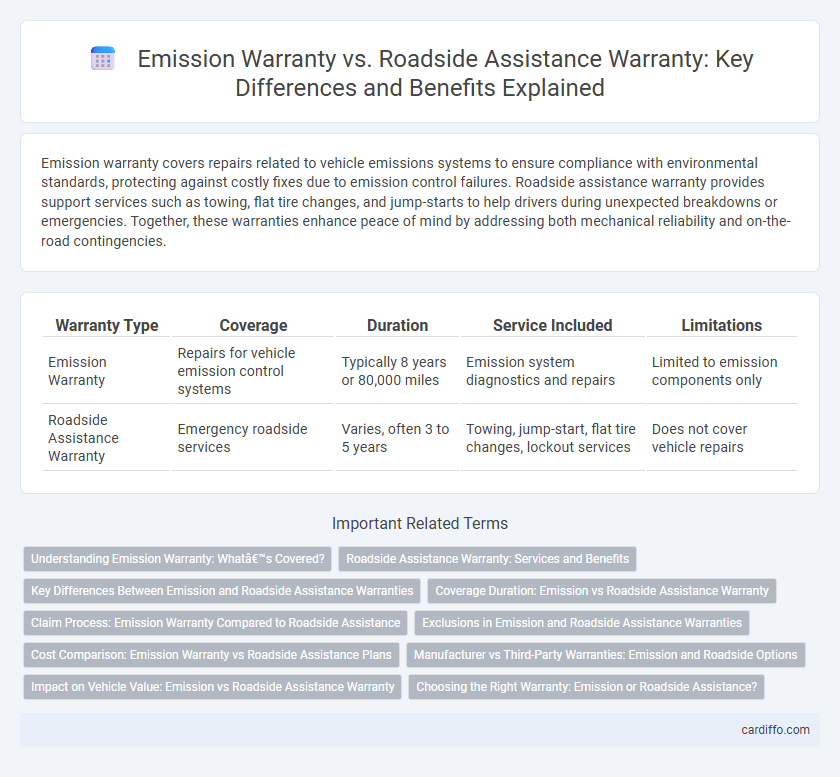Emission warranty covers repairs related to vehicle emissions systems to ensure compliance with environmental standards, protecting against costly fixes due to emission control failures. Roadside assistance warranty provides support services such as towing, flat tire changes, and jump-starts to help drivers during unexpected breakdowns or emergencies. Together, these warranties enhance peace of mind by addressing both mechanical reliability and on-the-road contingencies.
Table of Comparison
| Warranty Type | Coverage | Duration | Service Included | Limitations |
|---|---|---|---|---|
| Emission Warranty | Repairs for vehicle emission control systems | Typically 8 years or 80,000 miles | Emission system diagnostics and repairs | Limited to emission components only |
| Roadside Assistance Warranty | Emergency roadside services | Varies, often 3 to 5 years | Towing, jump-start, flat tire changes, lockout services | Does not cover vehicle repairs |
Understanding Emission Warranty: What’s Covered?
Emission warranty covers key components that control vehicle emissions, such as the catalytic converter, oxygen sensors, and evaporative emissions system, ensuring compliance with environmental standards. This warranty typically lasts longer than other coverage periods, often up to 8 years or 80,000 miles, reflecting regulatory requirements for reducing pollutants. Repairs or replacements under emission warranty prevent costly fines and maintain vehicle efficiency by keeping emissions within legal limits.
Roadside Assistance Warranty: Services and Benefits
Roadside Assistance Warranty offers essential services such as emergency towing, battery jump-starts, flat tire changes, and lockout recovery to ensure drivers receive prompt support during unexpected breakdowns. This warranty enhances vehicle reliability and driver confidence by providing 24/7 access to professional help, minimizing downtime and inconvenience. Benefits often include fuel delivery, trip interruption coverage, and concierge services, making it a comprehensive solution for on-road emergencies.
Key Differences Between Emission and Roadside Assistance Warranties
Emission warranty covers repairs related to your vehicle's pollution control systems, ensuring compliance with environmental regulations and typically lasting 8 years or 80,000 miles. Roadside assistance warranty offers services like towing, flat tire changes, and battery jump-starts, usually valid for 3 years or 36,000 miles. The primary difference lies in their scope: emission warranties protect against mechanical failures affecting emissions, while roadside assistance warranties provide emergency support for vehicle breakdowns.
Coverage Duration: Emission vs Roadside Assistance Warranty
Emission warranty coverage typically extends for 8 years or 80,000 miles, focusing on defects in emissions control components to ensure compliance with environmental regulations. Roadside assistance warranty duration often ranges between 3 to 5 years or 36,000 to 60,000 miles, providing services such as towing, battery jump-starts, and flat tire changes. The emission warranty is longer and specialized, while roadside assistance offers shorter-term emergency support.
Claim Process: Emission Warranty Compared to Roadside Assistance
The Claim Process for Emission Warranty involves providing proof of regular maintenance and timely reporting of emission-related failures to authorized service centers, often requiring detailed diagnostic tests to verify compliance with environmental standards. In contrast, Roadside Assistance Warranty claims prioritize immediate contact through dedicated service hotlines and on-site vehicle support without extensive documentation, emphasizing quick response over formal verification. Emission Warranty claims typically undergo longer processing times due to regulatory compliance, whereas Roadside Assistance claims are resolved swiftly to minimize roadside downtime.
Exclusions in Emission and Roadside Assistance Warranties
Emission Warranty exclusions typically omit coverage for damage caused by misuse, alterations, or failure to maintain the vehicle according to manufacturer guidelines, including the use of non-approved fuels or parts. Roadside Assistance Warranty exclusions often exclude services for vehicles used in commercial activities, incidents resulting from unauthorized repairs, or assistance beyond the geographic limits specified in the warranty. Both warranties explicitly exclude coverage for environmental damage and intentional or negligent damage.
Cost Comparison: Emission Warranty vs Roadside Assistance Plans
Emission warranties typically cover repairs related to vehicle pollution control systems for 8 years or 80,000 miles, minimizing potential out-of-pocket expenses for costly emissions component failures. Roadside assistance warranties, often available as extended service plans, involve a fixed annual fee but provide broad benefits such as towing, battery jump-starts, and lockout services, which can reduce unexpected expenses during vehicle breakdowns. Comparing costs, emission warranties are more focused on specific repairs with regulated durations, while roadside assistance plans offer ongoing service coverage with variable pricing based on provider and coverage tiers.
Manufacturer vs Third-Party Warranties: Emission and Roadside Options
Manufacturer warranties for emission systems typically cover repairs and replacements related to the vehicle's compliance with environmental standards, ensuring emissions control components meet regulatory requirements. Third-party roadside assistance warranties primarily offer emergency services such as towing, battery jump-starts, and tire changes, extending support beyond factory coverage. Emission warranties are governed by federal and state regulations, while roadside assistance plans vary widely in terms of provider, coverage scope, and duration.
Impact on Vehicle Value: Emission vs Roadside Assistance Warranty
Emission warranties significantly enhance vehicle value by ensuring compliance with environmental regulations and reducing the risk of costly repairs related to emission system failures. Roadside assistance warranties provide immediate support for breakdowns and emergencies, boosting buyer confidence but having a lesser direct effect on long-term vehicle resale value. Understanding the distinct impact of emission warranties in maintaining vehicle compliance is crucial for preserving both environmental standards and market demand.
Choosing the Right Warranty: Emission or Roadside Assistance?
Choosing the right warranty depends on your vehicle needs, where an Emission Warranty specifically covers repairs related to emissions systems mandated by environmental regulations, ensuring compliance and reducing pollution. Roadside Assistance Warranty offers emergency support like towing, battery jump-starts, and lockout services, providing immediate help during vehicle breakdowns. Prioritize Emission Warranty if long-term engine and regulatory compliance protection is crucial, or select Roadside Assistance Warranty for peace of mind in unexpected roadside emergencies.
Emission Warranty vs Roadside Assistance Warranty Infographic

 cardiffo.com
cardiffo.com